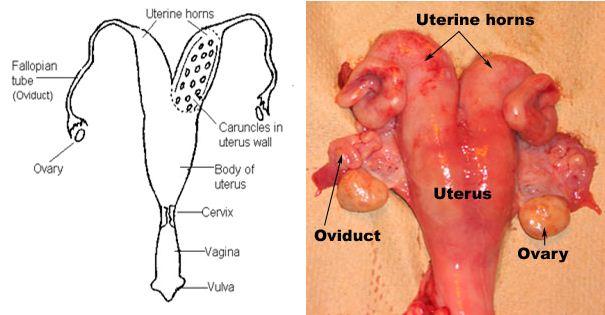The female reproductive system consists of two ovaries and the duct system involving oviducts, uterus, cervix, vagina and vulva. Ovaries produce ovum and sex hormones such as estrogens and progestins. The ovary contains numerous ova in various stages of development. Ovum developed inside follicles which are fluid-filled cavities. These follicles grow under the influence of FSH and LH which are main reproductive hormones. When these follicles riped then they rupture and release ovum into the oviduct. The ruptured ovumless follicle becomes progesterone releasing structure called corpus luteum.

In cows, follicle ruptures approximately 30 hours after the beginning of estrous or approximately 12 hours after the end of estrous. which is called ovulation. Follicle ruptures –> bleeding occurs –> corpus luteum (CL) begins forming. Size of the CL reaches peak on 15th to 16th day post ovulation. If animals become pregnant then CL continue until parturition, if not pregnant than CL regresses rapidly.
Next structure are oviducts which helps in transporting ova and spermatozoa. It also provide site where ovum and sperm meet and get fertilized. Its activity is stimulated by estrogen and inhibited by progesterone. Other important structure is uterus and its major functions are to retain & nourish embryo/fetus. Nourishment comes from yolk in embryo or uterine milk. Later placenta (tissue connection between fetus and mother) is formed which convey nourishment to fetus and carry waste product out of fetus. Estrogens increase the uterine tone & progestins decreases it.
Cervix: it is thick keratenous/hard tube like structure between inner uterus and outer vagina. Estrogens causes cervix to secrete mucus which has antibacterial action. During pregnancy the mucus become gel like plug protecting uterus from infection or abortion.


Vagina and Vulva are outer structures of reproductive system which act as recepters of male germplasm for coception.








